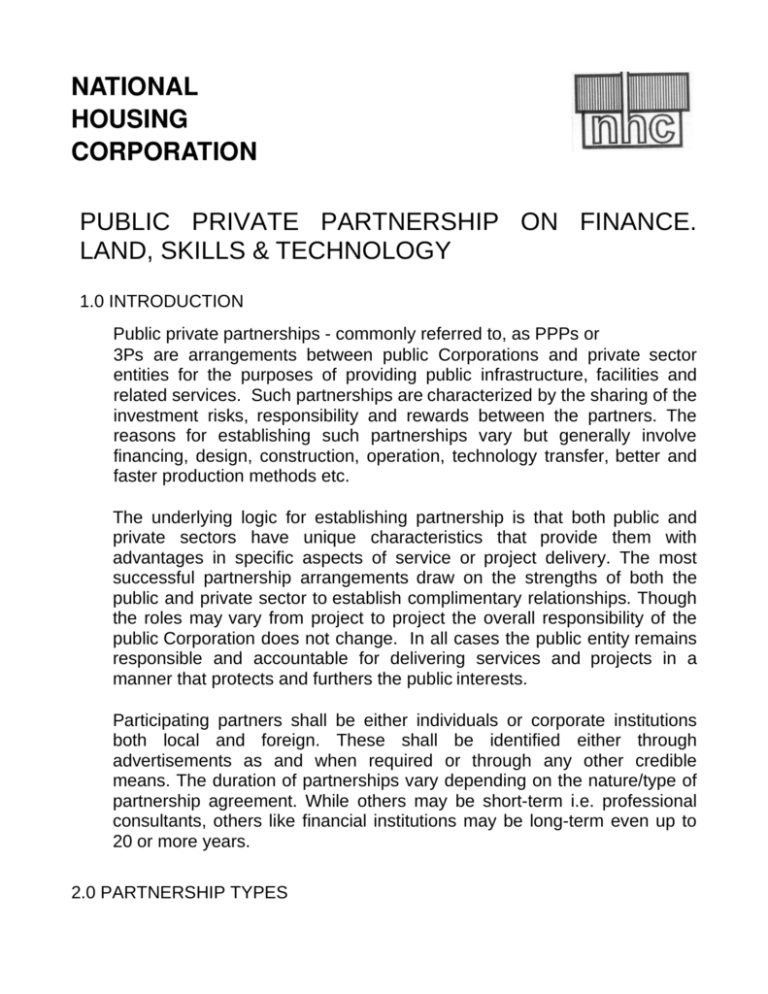to view the NHC Public Private Partnership Document
advertisement

NATIONAL HOUSING CORPORATION PUBLIC PRIVATE PARTNERSHIP ON FINANCE. LAND, SKILLS & TECHNOLOGY 1.0 INTRODUCTION Public private partnerships - commonly referred to, as PPPs or 3Ps are arrangements between public Corporations and private sector entities for the purposes of providing public infrastructure, facilities and related services. Such partnerships are characterized by the sharing of the investment risks, responsibility and rewards between the partners. The reasons for establishing such partnerships vary but generally involve financing, design, construction, operation, technology transfer, better and faster production methods etc. The underlying logic for establishing partnership is that both public and private sectors have unique characteristics that provide them with advantages in specific aspects of service or project delivery. The most successful partnership arrangements draw on the strengths of both the public and private sector to establish complimentary relationships. Though the roles may vary from project to project the overall responsibility of the public Corporation does not change. In all cases the public entity remains responsible and accountable for delivering services and projects in a manner that protects and furthers the public interests. Participating partners shall be either individuals or corporate institutions both local and foreign. These shall be identified either through advertisements as and when required or through any other credible means. The duration of partnerships vary depending on the nature/type of partnership agreement. While others may be short-term i.e. professional consultants, others like financial institutions may be long-term even up to 20 or more years. 2.0 PARTNERSHIP TYPES There are several kinds of partnerships ranging from design, financing, build operate and transfer, leasing, turnkey etc. However, due to the unique mandate of the Corporation the most critical areas of partnerships to be considered include, land, finance, skills and technology. 2.1 LAND An individual or a corporate entity with land for housing development may approach the Corporation for either skills or finances or both in order to have the land developed. In this case the Corporation will have to undertake a viability assessment before having the land valued preferably by the Chief Government Valuer in order to ascertain the land value taking into account the needs of the Corporation housing development program. The value of the land will therefore be the equivalent equity contribution of the landowner towards the project development. The land location and the income category shall be determined by the need as ascertained in the project document (NHC investment portfolio). 2.2 FINANCE In the past the Corporation has depended entirely on Government funding for project development. With the changing circumstances, the Corporation must look for ways and means of having projects financed if it has to remain relevant and sustainable. The Corporation is prepared to approach any credible financiers, both internally and externally with affordable finances to come on board. 2.3 SKILLS In the past, the Corporation though having a fully-fledged Technical department has been commissioning external consultants to undertake some of its projects. When the need arises especially where the workload internally is overwhelming, the corporation can team up with external consultants to ease the burden. In some instances, the Corporation may team up with some consultants for the sole impartation and transfer of any much but critically needed skills. 2.4 TECHNOLOGY Shelter delivery processes are constantly changing with the changing technological advancements. The current building systems in Kenya are both expensive and restrictive in terms of delivery time, use of appropriate technology, and materials for construction purposes. Industrial building systems (IBS) currently in operation in both the Western world and Asia are capable of revolutionizing the Construction industry through reduced time frame; reduced wastage of material hence reduced cost, conservation of environment through minimal use of plantation timber amongst others. However, the initial capital-outlay for the establishment of these muchneeded technological advancements (building systems), is out of reach for the Corporation, at the moment. For the Corporation to address this issue adequately, there is therefore need for partnering with the relevant interested partner institutions that can make it realize this noble objective 2.5 TURNKEY - BUILD AND TRANSFER- FACILITATION Another area of partnership, which the Corporation is critically looking at, is the type of facilitation that has enabled some south East Asian countries like South Korea, Thailand, Malaysia etc. to produce affordable houses in large quantities. In this type of partnership, the Corporation's, responsibility will be to identify end construction financiers, buyers and approve designs only and leave construction and financing to developers. The Corporation will only specify the types of the houses to be built, size of the units, material specifications, total number, location of the projects and the maximum amount (cost) to be paid for each unit (fixed sale prices) when completed. The developer then will be in charge of design, construction and financing of the project with periodical supervision and approval from the Corporation to ensure quality compliance. The identified end financiers will then channel the funds through the Corporation on agreed terms for the purchase of the respective units from the developers. This way more units are expected to be rolled out, as there are likely to be many more players involved at any one time. 3.0 IMPLEMENTATION The implementation process shall be informed by the following parameters A) ROLES/RESPONSIBILITIES OF PARTNERS The roles and responsibilities of each partner must be clearly defined and agreed upon to avoid any ambiguity in the implementation of the partnership program. Since partnerships differ, specific roles and responsibilities shall depend on the specific type of partnership under consideration and the roles shall be spelt out in their memorandum of understanding or contract document agreed upon prior to implementation/approval by both parties. B) EQUITY Equity contributions of each of the participating partners shall be determined and agreed upon before any binding contract document is signed. This is what shall determine the value of the profit/compensation to be given to each partner. C) RETURN ON INVESTMENT (ROI) The provisional ROI shall be determined based on each project business proposals and this shall be agreed upon right at the beginning. Any variations either way shall be borne by the partners according to their equity contributions. D) COMPENSATION/PROFIT SHARING There may be instances whereby some participating partners may opt for gradual/progressive compensation based on their financial commitment as well as the project progress. In these instances appropriate compensation values shall be worked since cash is being withdrawn in the course of the project. In other cases where profits are to be shared upon successful completion and sale of projects, the proportionate amounts shall be determined by each partner's equity contribution. All these must be worked out and agreed upon before signing of the partnership agreements. E) PARTNERSHIP DOCUMENT This document shall be done in such a way that it is easily understood and very clear on these fundamental issues. It must have clear guidelines on the implementation procedures especially those on exit and conflict resolution clauses, with well-articulated contingent consequences. F) PARTNERSHIP REGULATIONS To operationalize this partnership, NHC has developed comprehensive regulations to guide its effective implementation. The guideline shall indicate clearly: Process of partnership initiation/identification with specific roles and responsibilities Analysis and synthesis of the proposals - equitable and fair evaluation Approval processes/procedures that are needed before their eventual implementation, to be structured depending on the prevailing public procurement, Act/Regulation. G) MONITORING AND EVALUATION A team of experts shall be set up by both parties to monitor and evaluate the progress based on the partnership agreement. The element of partnership regulation for efficient and responsible partners must be accorded due attention. h) BENEFITS Partnerships generally result into the following benefits: Cost reduction due to increased competition Increased/improved services due to pooled resources Improved revenues - due to pooled relevant resources Release of public funds for other critical services.






